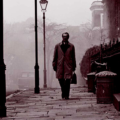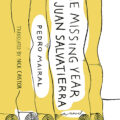Noli me tangere

In 1939, as London braced itself for the bombs, the National Gallery’s paintings were moved to the dining room of Penrhyn Castle, North Wales. It wasn’t necessarily safer. Martin Davies, in charge of the evacuation operation, wrote back to his colleagues in London that the castle’s owner, Hugh Napier Douglas-Pennant, was regularly drinking more than prudent—“He stumbled with a dog into the Dining Room a few days ago”—though a subsequent accident with a motorcar under similar circumstances had mitigated the risk, for now.
An unusual Neo-Norman edifice straddling the Menai Strait, Penrhyn had been built by Douglas-Pennant’s ancestors in the middle of the nineteenth century, on money from the local slate industry. Many of the twentieth-century family had been killed in the First World War, which partially accounted for the current incumbent’s drinking, and the National Gallery’s black and white photographs of the picture show the ancestral seat looming over proceedings, its stark lines lending it a proto-Brutalist air that Kenneth Clark, the Gallery’s Director, dubbed “exceptionally dismal.”
The castle had been selected as a safe-house for the Gallery’s pictures primarily because it had doors large enough to accommodate their largest one, Van Dyck’s Charles I on Horseback (1637-8), a splendid seventeenth-century pean to an ineffectual martyr-king. At some twelve feet tall, this inconveniently oversized canvas would have dwarfed its famously diminutive sitter, and the canny Van Dyck rendered his five-foot patron even more imposing by painting him astride a horse bred for its unusually small head. Atop this triumph of perspective, Charles appears in full armor, in front of a plaque declaring him king of “the British Isles,” a title he is poised to ride out and defend, if necessary, in the varnish-gold landscape before him. Within the decade, suddenly materialized enemies would deliver his head to the executioner’s block.
Three hundred years later, this king of the British Isles travelled to wartime North Wales in a specially-made triangular construction known as the “elephant case,” crossing the border on the back of a truck.
After 1940, when the air-raids began, Kenneth Clark decided that, over and above its dismal air and potentially sacrilegious owner, Penrhyn was also dangerously close to Liverpool, whose docks would become targets for German bombs. The pictures needed to be moved somewhere more remote. He presented the Prime Minister with two options: the nation’s paintings might travel to an as-yet-unknown location in Canada, or they could be kept inviolate in the cave known as the “Cathedral,” in the centre of a disused slate mine in “the hellish town of Blaenau Ffestiniog,” also in North Wales. The reply was typically Churchillian: “Bury them in the bowels of the earth, but not a picture shall leave this island.”
The move to the mines accordingly began in August 1941, and the Gallery’s archive photographs show the long journey over desolate roads cut into the Welsh hills, across rickety tracks into the darkness, chiaroscuro-lit by conservators’ lights. The elephant case brought up the rear, bearing both Charles I, and Sebastiano del Piombo’s The Raising of Lazarus, an image of resurrection that bears the honorific “NG1”—it was the National Gallery’s first acquisition in 1824. Once established in the underground Cathedral, in white canvas tents that offered little proof against the constant risk of subsidence, the paintings were overseen directly by Davies, who took up residence in a small, perennially overshadowed farmhouse nearby, surfacing daily only to dive down into the caves with a torch and a magnifying glass.
The culmination of this subterranean hermitage would come at the end of the war with a series of National Gallery catalogues, authored by Davies, on the paintings from the British, French, and Netherlandish collections. The Oxford-educated Kenneth Clark reassures his readers, in a tone of barbed camaraderie, that his colleague “was said by his contemporaries in Cambridge to have emerged from his rooms only after dark; so this sunless exile was not as painful to him as it would have been to a less unusual man.”
Once the Gallery’s pictures were established underground, the empty building itself stood surplus. In its position at the centre of Trafalgar Square, it was expected to be appropriated by a wartime Ministry. But while the frames gaped in the halls, the public’s spirits were marshalled within it by music. The renowned pianist Myra Hess, whose 1926 setting of Jesu Joy of Man’s Desiring was already a standard at British weddings and funerals, offered Clark a series of lunchtime concerts in the Gallery. The doors would be thrown open again. These concerts quickly became a fixture, and Hess herself would emerge from the war linked irrevocably with Bach’s cantata and with what quickly became known as “Blitz spirit.” Draped in dark furs and an air of grim endurance, Hess was viewed as a solid figure of constancy. When another part of the Gallery took a direct hit, she rose to a crescendo.
Clark records her suspicion of Mozart—“He changes so terribly”—and “her” piece, Bach’s piece, is a exemplar of gradual evolution, its gentle fugal structure linking element to stately element with quiet, unfussy confidence. Like Hess herself (born in Kilburn to Jewish parents) it had German roots, the title originally rendered as “Herz und Mund und Tat und Leben” (“Heart and Mouth and Deed and Life”). Loosely drawn from the “Magnificat” offered to God by the Virgin Mary, they reflect the cantata’s origins: Bach’s setting originally premiered in Leipzig on the Feast of the Visitation in 1723. Its original German audience would, then, have recalled how, after the Annunciation, Jesus’s expectant mother visits her aging, once despairingly barren cousin Elizabeth. But Elizabeth, too, is miraculously with child; a babe that “leaped in her womb” at the approach of Mary bearing the Son of God, prompting the Virgin’s song of praise.
Church-going listeners in 1940s London, however, would probably have thought (patriotically or otherwise) of the English, rather than the German, text that ran along Hess’s playing, even as Allied bombs rained down on Bach’s Leipzig. Not of thanksgiving, then. In the English version, penned by Poet Laureate Robert Bridges, the upward progression of the fugue is accompanied by a yearning for God: “Striving still to truth unknown, / Soaring, dying round Thy throne.”
Set thus, the solidity of Jesu Joy of Man’s Desiring becomes more anxious hope than pregnant celebration. Kenneth Clark wept at Hess’s first performance in the National Gallery, finding here a confirmation of “eternal values.”
However much Hess may have evoked the marveling of the Magnificat or the blind faith of the hopeful, the bereft public still wanted their paintings. “Because London’s face is scarred and bruised these days,” ran a letter in the Times, “we need more than ever to see beautiful things. Would the trustees of the National Gallery consider whether it were not wise and well to risk one picture for exhibition each week?”
The proposal found favor in the denuded offices of the National Gallery, but which of their two thousand-odd pictures did the public want to see first? The collection already included major art historical representations of the aftermath of the Visitation, images of love and magnificence, purchased in the years after NG1. Christ and John the Baptist, cousin children of the pregnant virgin and the fruitful geriatric, appear in hale and chubby glory in Leonardo da Vinci’s Madonna of the Rocks, today reverently lit in a private chamber in the Sainsbury Wing, full of traipsing tourists, not far from Raphael’s immaculately composed Garvagh Madonna. Grouped with the earlier generation is Piero della Francesca’s Baptism of Christ, where the adult John performs the sacrament for which he was born, with water from a limpid pool, on a clear day in Tuscany.
Clark was reportedly surprised by the public’s answer. They wanted NG270, the teenage Titian’s small early painting, Noli me Tangere.
On the first day of the week, as John 20 has it, Mary Magdalene came to the tomb and saw that the stone had been rolled away. John is not unique in the Gospels in giving this discovery to a woman, but his is the only account that has Mary coming alone. When she finds the body gone, she panics and casts about for passers-by. She lights on a gardener. Where had “they” taken the body? The gardener replied, addressing Mary by name, and she immediately recognized Christ himself, risen again as foretold. “Rabboni” (Master), she replied, but her master pulled away. “Touch me not,” he said, “for I am not yet ascended to my father.” In the Vulgate Bible, from which most sources drew until the seventeenth century translation (authorized by King Charles’s father, James I) his words are rendered in Latin: “noli me tangere”; do not touch me.
This is the moment the teenage Titian chose for the painting Londoners requested in the middle of the Second World War. Mary Magdalene, a supposed former prostitute who has thereby known the touch of many, appears loose-haired in accordance with long-established iconographic tradition—a trope that has been linked variously to her erstwhile profession and to her subsequent period of repentance in the desert. Titian drapes her in the kind of sumptuous scarlet he might have seen passing his studio window in prosperous sixteenth-century Venice, but she kneels in the dust, careless of fashion and clutching the ointment she brought to anoint her master’s body. That body appears miraculously re-animated, still in its white winding sheet, and Christ tramples on the green vegetation that appears to have sprung spontaneously from the earth, as he has. Mary reaches forward a tentative hand. The Rabboni, bearing his gardener’s hoe like a staff of office, leans towards her in answering reassurance, even as he pulls away the very hem of his garment and speaks the words that give the painting its name. The practical space between the figures is small and, from a distance, indistinct. Titian holds his figures together within a compositional triangle that seems to speak of the love that flows between them and, in some vaguer sense, unites them.
Titian painted Noli Me Tangere around 1514, in a rich creative period immediately following his return to the canalled city of his birth. With the departure of Sebastiano del Piombo for Rome—where he would meet Michelangelo and paint NG1—the field for the ambitious young Venetian was clear. The resultant painting is the work of an artist whose desire to impress is clear from the virtuoso array of whites in the drapery around his two figures. From the dissolving veil at Mary’s breast and the semi-sheer sleeve, to the cold linen of the grave cloth gathered up against Christ’s intricately knotted, wispy loincloth, the whole is a rich assortment of textures and transparencies.
The Vulgate’s “noli me tangere” had already solidified as a meme for poets and classically educated young aristocrats, though its precise relationship with John 20 was far from clear. There is an apocryphal story from ancient Rome about a hind roaming the parks three hundred years after Julius Caesar’s death that was still wearing a collar warning the huntsman to “noli me tangere” because “I belong to Caesar,” a pitiful remnant of former magnificence now trampled in the dust. Petrarch translated it to “Nessun mi tocchi” in his 190th sonnet, addressed to his pseudonymous mistress “Laura” (whose name translates as the untouchable “L’aura”: “the air”). And it was in remembrance of each of these that Titian’s younger contemporary, the poet and courtier Sir Thomas Wyatt, reached for the same formulation when thinking (it is thought) of his childhood companion, his beloved Anne Boleyn. Wyatt’s poem, a loose translation of Petrarch, imagines the longed-for Anne as a “hind” eluding the huntsman. Around her neck is the same invocation “graven with diamonds”: “Noli me tangere, for Caesar’s, I am.” As it turned out, barely ten years later, Anne’s untouchability was tested in a sham adultery trial and graven on her neck in earnest by the French executioner’s sword. Caesar’s, I am. Magnificence still reigned.
With its evocation of prohibition and longing, Noli Me Tangere must have resonated with Blitzed Londoners, as, presumably, with many before them. Titian’s youthful pastoral, complete with a man walking his dog, combines the everyday with the miraculous. Yet the central miracle is witnessed only by us, and by a single woman—a putative prostitute at that—whose testimony would have been automatically suspect to her male Christian colleagues. And though there is a subtle magic hanging over the scene, there is no obvious sign of what, exactly, has happened. The dark tomb from which Christ has risen, and the stone that was rolled away, are nowhere to be seen. Instead, rolling hills fade to blue below a sleepy hilltop town, where sheep safely graze, the colors only subtly intensifying in the areas surrounding the man who rose from the dead.
Those who climbed the steps of the National Gallery to see the painting on lonely display might perhaps have thought of those they could not touch: family and friends at the front, ricket-riddled children evacuated to far-off English idyll; or perhaps those whose touch might heal: doctor, peacemaker, lover. Listening to Jesu Joy of Man’s Desiring echo through the halls, they might also have thought both of the desire to hold and cling, and of the conflicting necessity to strive “still to truth unknown.”
However, as they watch Mary’s hand hovering longingly in the air, from that century to this, Titian’s viewers might also, variously, remember that John 20 is marked by touch. Immediately after meeting Mary in the garden and refusing her the immediate consolation she seeks, Jesus instructs his doubting disciple Thomas to “reach hither thy finger […] and thrust it into my side: and be not faithless, but believing,” an invitation to touch that is as insistent as his previous prohibition from touching. The scene has enjoyed equal (marginal) status among artists with Noli Me Tangere. A rare early example is the National Gallery’s version by Giovanni Battista Cima da Conegliano, which situates Christ and his companions within a white-walled structure, through whose windows an Italian pastoral (always, distantly, present) may just be glimpsed. Cima’s Christ is smooth as the architecture around him, as he presents his naked torso to Thomas to touch, and Thomas’s tentative movement seems all the more transgressive for it. But it would not be until the Counter-Reformation, and its emphatic focus on the practicalities of the Passion, that the unapologetic bodily significance of this moment would be equivalently rendered in paint. One hundred years after Titian, the Bolognese painter Guercino produced his version of The Incredulity of St Thomas, hanging today with the National Gallery’s later Italian works. Worlds away from Titian’s small-scale georgic, this painting focuses with almost obscene insistence on the finger of Thomas penetrating the bloody flap of skin in his master’s side. The chiaroscuro picks out details of frail human flesh against the darkness. Confused, flabby wrinkles pucker under balding heads, and weak eyes peer insistently into the body, as it yields to the finger that prods it.
The specific implications of these moments of touching and not touching in their Biblical context are made clearer with reference to the Greek verb from the original rendition of John. This is not “tangere” (“to touch”) but “haptou,” a similar word, but with the wider implication “to take hold of, hold.” Theologians have often read Christ’s words to Mary Magdalen, seemingly so devoid of comfort, as a reproof. She, and we with her, should not “cling onto” the master’s earthly presence, but should look on him as “ascended to my Father.” To truly believe, they say, is not to check with greasy finger, as Thomas does, but to believe, untouching.
Inspiration and redemption come at the uncertain sight of a miracle, or the fleeting sound of a voice, like John the Baptist leaping in the womb of his mother. Guercino’s painting, full of dramatic folds and flows, suggests this hierarchy of belief: from right to left, a peering face, a faceless ear, and the intrusive touch of incredulous Thomas, perhaps already regretting his insistence. The correct response is perhaps best incarnated in the figure at the left, behind Christ. He looks—of course he looks—but he also raises his hand in horrified prohibition. He already believes. “He is risen.”
This man is not much looked at today himself, at least on the National Gallery’s main trail. Tourists tend to gather instead around the luscious, pointedly secular flesh of Vélasquez’s Rokeby Venus opposite. She has her own wounds, which have also miraculously healed. In 1914, the suffragette Mary Richardson slashed her seven times with a meat cleaver, saying she “didn’t like the way men visitors gaped at it.” It is often commented that the horror expressed at this act outweighed concern for flesh and blood women like the suffragette leader Emmeline Pankhurst, languishing in a London gaol. For, when Titian’s Noli me Tangere joined the collection in 1856, its titular proscription hardened into the rules and regulations governing the museum as a whole, still occasionally barked by attendants and curators.
Look, by all means. These pictures have travelled the world, from churches and chateaux and palazzi and picture-dealers. They have been stored in vaults and chambers; they have returned, scarred, from the mines. But your hands sweat acid that corrodes, and gather dust that lingers. Today, many of them, including Leonardo’s Madonna and child looming out of sfumato shade, are behind a hi-tech glass that is almost invisible, a force-field that ensures that, even if you wanted to, you couldn’t. In an age when John 20 is not much read and mechanical reproductions line the gift shop, these paintings that returned from the mines of purgation are as diamond-graven as Caesar’s deer, ungraspable as the hem of his garment.
Pictured: detail of Titian’s Noli me Tangere
About Kirsten Tambling
Kirsten Tambling is a PhD candidate in the History of Art at Birkbeck, University of London. Her writing has previously appeared in The Inkling, Apollo Magazine, and The Rumpus.





